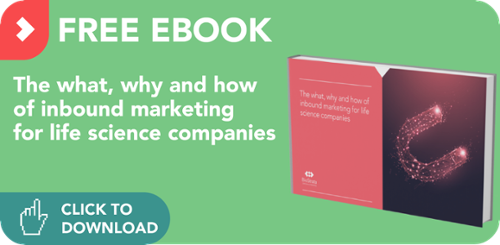Nowadays, prospects find out about your company, products and services by looking at online reviews, blogs, application notes, eBooks, buying guides, demo videos and by asking their peers (often long before they engage with your sales team).
Inbound marketing draws prospects in with content they care about and that interests them. By providing such content, you can raise awareness of your products/services and earn the trust of prospects before they make purchasing decisions.
Although 'content is king' with inbound marketing, your content will only be effective if it’s relevant to your prospects and is strategically implemented. To give your inbound campaign the best chance of success, it needs to be carefully planned - so here we’ve compiled a list of nine important elements that should be considered when building a winning inbound marketing campaign for your life science business (if you’d like even more insights on how inbound marketing can help you connect with your life science customers, download the full eBook on this topic).
1. Your life science marketing plan and strategy starts with your buyer personas
The success of your inbound campaign depends on a targeted and well-planned content strategy that speaks to the pains and gains of your target audience. The first task is to develop buyer personas – semi-fictional representations of your ideal customers based on real-world information, data and research (such as customer interviews and surveys). By developing personas, you’ll gain a deep understanding of your prospect’s goals/challenges, and how your products and services will help them (which will in turn allow you to generate content that speaks to these elements).
2. Engage, educate and entertain life science prospects and customers with relevant content
We've said it before - content is the lifeblood of any inbound marketing approach. Blogs and social posts attract visitors to a brand’s website, whereas the promise of content that actually helps consumers address their challenges compels them to volunteer their contact details. High-value content allows you to build trust with your target market and establish your expertise. By using content to engage, educate and entertain your prospects, you can influence them, generate sales leads and help close customers, all without overtly selling.
3. Your website needs to be user-friendly and resonate with your life science customers
For many life science companies, your website functions as a content publishing platform and a lead generation tool, so it needs to be straightforward to navigate and easily searchable. It’s important that the content housed on your website speaks directly to the needs, goals, challenges and pain points felt by your customers, and that within this content the all-important value proposition is delivered as the best possible solution in a compelling and helpful way.
4. Stay tuned in to SEO updates and the latest life science blogging topics
If you're publishing and promoting content in a blog, it’s crucial to stay in touch with the latest search engine optimisation (SEO) recommendations, as well as information on algorithm changes made by search engines like Google. In terms of blogging topics, you also need to stay tuned in to your buyers’ pain points and interests to develop the most relevant content. Do this and you’ll be viewed as a thought leader by your customers - which will increase the likelihood of them sharing your content with peers.
5. Maximise your life science marketing plans and campaigns with social posting
Even though your inbound marketing programme will be powered by the content housed on your website, you’ll also rely on social media channels such as Twitter, LinkedIn and Facebook to promote your content to a wider audience. With an ever-increasing number and popularity of social media platforms, it’s important to identify the most relevant channels for your campaign, and how to connect with groups in an appropriate way for each channel. Be aware that many platforms limit the reach of organic posts, therefore, you may need to invest in sponsored posts, native advertising or other paid ad formats.
6. Use lead-generating forms and tactical life science marketing approaches to nurture leads
Although the goal of inbound marketing is to convert interested visitors into customers, not all prospects are ready to purchase. The lead generation forms in front of your high-value content pieces can be used to collect useful information about your prospects – this also allows you to gauge where they are in their buying journey. By pairing this with lead-nurturing tactics, such as highly targeted emailers, you can nudge people through their individual buying journey with engaging content.
7. Automate the scheduling and publishing of your content
By managing the scheduling and publishing of your content, marketing automation platforms such as HubSpot can improve the efficiency and cost-effectiveness of your inbound campaigns. They manage publishing and metric tracking automatically – making campaign monitoring faster and easier (which can help with making real-time adjustments to your programmes). By automating the lion’s share of lead management, tracking and nurturing tasks, you could improve your campaign’s efficiency and manage your time more effectively.
8. Use a reliable customer relationship management (CRM) system
Some marketing automation software can also handle your CRM, helping you to segment your database into your different buyer personas and further categorise them by life cycle stage (into contacts, leads, marketing qualified leads (MQLs), sales qualified leads (SQLs), opportunities and customers). By monitoring which pieces of content bring in the most leads, you can identify the most successful conversion techniques and bridge any gaps between your marketing and sales processes. For example, an automation platform can manage your prospects from marketing’s first touchpoint to close-of-sale, giving you all the data you need to scale-up your efforts and generate more customers.
9. Analytics can help refine your life science marketing plan and strategy
So how do you know which campaigns work and which don’t? Once again, marketing automation platforms can help. Such software can measure the success of your inbound campaigns across numerous metrics, including visits to your website and blog posts, referral sources, types of downloaded content and how your visitors engage with your website. By probing the conversion rate data, you can tweak your campaign in real-time, focussing on the most effective tactical elements.
Orchestrate these key elements in concert to develop a winning life science marketing plan and strategy
So while inbound campaigns are dependent on the quality of the content, this is just a single element. The planning and implementation of your campaign also has a great bearing on its success. The nine components of your inbound marketing strategy illustrated here are more than a sum of their parts. When you pool these resources, you’ll have the opportunity to move prospects through the sales funnel – which will do wonders for your ROI. To find out more about how to execute the perfect inbound marketing programme, download the eBook today.




